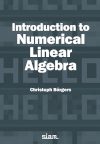- About MAA
- Membership
- MAA Publications
- Periodicals
- Blogs
- MAA Book Series
- MAA Press (an imprint of the AMS)
- MAA Notes
- MAA Reviews
- Mathematical Communication
- Information for Libraries
- Author Resources
- Advertise with MAA
- Meetings
- Competitions
- Programs
- Communities
- MAA Sections
- SIGMAA
- MAA Connect
- Students
- MAA Awards
- Awards Booklets
- Writing Awards
- Teaching Awards
- Service Awards
- Research Awards
- Lecture Awards
- Putnam Competition Individual and Team Winners
- D. E. Shaw Group AMC 8 Awards & Certificates
- Maryam Mirzakhani AMC 10 A Awards & Certificates
- Two Sigma AMC 10 B Awards & Certificates
- Jane Street AMC 12 A Awards & Certificates
- Akamai AMC 12 B Awards & Certificates
- High School Teachers
- News
You are here
Introduction to Numerical Linear Algebra

Publisher:
SIAM
Publication Date:
2022
Number of Pages:
348
Format:
Paperback
Price:
79.00
ISBN:
978-1-611976-91-5
Category:
Textbook
The Basic Library List Committee suggests that undergraduate mathematics libraries consider this book for acquisition.
[Reviewed by , on ]
Bill Satzer
08/1/2022
In the preface to this book the author describes his search for a text on numerical linear algebra that students could read on their own. This was intended for a course at the upper-level undergraduate or early graduate level for students who had a one-semester linear algebra course already, and his idea was to try a sort of “flipped classroom” approach. He wanted to concentrate on discussing students’ questions and solving problems without lecturing. After failing to find a suitable text, the author chose to write his own.
As a member of a group who learned numerical linear algebra on our own many years ago while developing new algorithms for signal processing, I have a kind of retrospective envy of this new book. We had some good sources to use back then (an early edition of Golub and Van Loan, for example), but that was difficult. Mostly we learned from one another.
In the last several years, numerical linear algebra has become a topic of much wider interest, and courses in the subject have become more common. Much of this has to do with new emphasis on analysis of data, particular big data sets used, for example, in data mining, statistical learning, and image analysis.
The author’s approach is surprisingly gentle. He writes as if speaking directly to students and what he says is clear and easy to read. He begins by reviewing the basics of linear algebra. The treatment is generally theoretical - not overwhelmingly so – and a number of good applications are included. Where there are proofs, they are intended to illuminate. The first several chapters discuss subjects like basic matrix decompositions, matrix norms, condition numbers and consideration of the difficulties arising with ill-conditioned linear systems.
The computational tools presented include both direct and iterative methods for solving linear systems of equations as well as the standard methods of computing eigenvalues and eigenvectors. Special matrix forms (symmetric, positive definite, banded, sparse and so on) are presented and special methods appropriate to each of them are described.
The author uses an application with diffusion to show how very large linear systems can arise. Using a finite grid he describes modeling the spread of a pollutant in a straight channel. This leads on one hand to the Poisson equation in the limit of small grid spacing, and then later in the book to a discussion of the influence of matrix condition number on the efficiency of iterative methods for discrete solutions of linear systems where large condition numbers are encountered. When the author considers non-square linear systems, he does so in the context of a computed tomography example, and then a well-chosen example with the Global Positioning System.
The author introduces the Singular Value Decomposition (SVD) fairly late in the book, and this is a little surprising considering its importance in many applications. He does provide a good application to image deblurring and descriptions of how the SVD deals with rank-deficient least squares problems.
Multigrid systems are considerable enhancements of the more traditional Jacobi and Gauss-Seidel methods for iterative solution of linear systems, and they get a brief treatment right at the end of the book. The author includes a number of more advanced topics like this, more material than could be covered in one semester. This gives an instructor some flexibility to include or omit more advanced topics.
This is a strong book. I found the author’s treatment of ill-conditioned systems and stability of algorithms throughout the book to be particularly worthwhile. These frequently underlie failure of numerical methods in practice. The author’s writing style is also attractive, and likely to appeal to students. Exercises appear in the book where they are relevant, and solutions to selected ones are provided. MATLAB code is included when the author believes the code would help make the text clearer.
Bill Satzer (bsatzer@gmail.com), now retired from 3M Company, spent most of his career as a mathematician working in industry on a variety of applications. He did his PhD work in dynamical systems and celestial mechanics.
See the publisher's website.
- Log in to post comments




